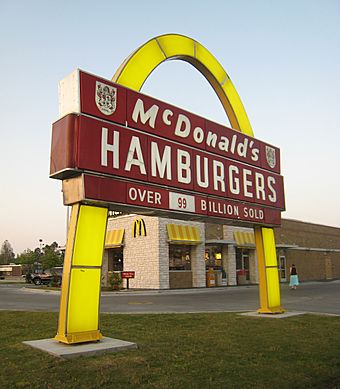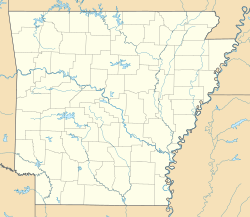McDonald's sign (Pine Bluff, Arkansas) facts for kids
Quick facts for kids |
|
|
McDonald's Store #433 Sign
|
|
 |
|
| Location | 2819 S. Olive St., Pine Bluff, Arkansas |
|---|---|
| Area | less than one acre |
| Built | c. 1962 |
| Architectural style | Single-arch McDonald's sign |
| NRHP reference No. | 06000411 |
| Added to NRHP | August 21, 2006 |
The McDonald's Store #433 Sign in Pine Bluff, Arkansas, is a very special and rare sign. It is one of only a few left that show the old single-arch design of McDonald's. This sign was first put up in 1962. It stayed at its original spot until 2007. That year, McDonald's Store #433 moved to a new place. The sign was carefully fixed up and moved too. Because it is so unique, this McDonald's sign was added to the U.S. National Register of Historic Places in 2006. This means it is an important part of American history.
Contents
The Historic McDonald's Sign in Pine Bluff
A Look Back at Its History
The area around South Main Street in Pine Bluff used to be mostly homes. But in the middle of the 1900s, more businesses started to open there. In 1962, a man named Mike Retzer built McDonald's Store #433. It was located at 1300 South Main Street. The building looked like other McDonald's restaurants from that time. It had a bright red, white, and yellow design. It also featured arches that went through the roof. The restaurant first opened its doors on July 3, 1962.
In August 2007, people learned that the old McDonald's location would close. A brand new building was being built about two miles away. This new store was on South Olive Street. At first, no one knew what would happen to the old sign. But by September 2007, it was decided that the special sign would move to the new location.
That September, workers carefully took the sign apart. They moved it to a company called Skylite Sign & Neon in Mabelvale, Arkansas. There, experts worked to fix and restore the sign. This renovation work took about a month to complete.
What Makes This Sign Special?
The Unique Single-Arch Design
The McDonald's sign in Pine Bluff shows an important change in McDonald's history. It came after the "Speedee" sign and just before the famous double golden arches we see everywhere today. This single-arch design was only used for about one year. Because of this, it was rare even back then. Today, it is much, much rarer. The very first double golden arches sign appeared only three months after the Pine Bluff store opened.
Like other single-arch signs from McDonald's early days, the Pine Bluff sign has plastic panels. These panels are held in a strong metal frame. There is also a red space in the middle for advertising messages. The company Sign Crafters in Evansville, Indiana, made the sign. The plastic parts came from the Rohm & Haas Company in Philadelphia.
The Meaning Behind the Arch
Ray Kroc, who helped make McDonald's famous, designed this type of sign. He got the idea after seeing a picture of the McDonald family's crest. The arch shape itself reminds us of "modernism." This was a style of art and building that was popular then. It focused on new ideas and simple, clean shapes.
One expert, Phillip Langdon, wrote about the meaning of the arch. He said it showed a "buoyant spirit." This means a happy, hopeful feeling. It was like looking up at the sky, full of energy. It also connected to the "Space Age," when people were excited about space travel. The arch was meant to make a simple hamburger stand look modern and exciting.
Why This Sign is Important
A National Treasure
The U.S. National Register of Historic Places officially added the Pine Bluff McDonald's sign to its list on August 21, 2006. It was listed as "McDonald's Store #433 Sign." McDonald's has used many different sign designs over the years. This means that very old signs are incredibly hard to find. The Pine Bluff sign is the only known single-arch McDonald's sign from that early period that still exists. It is also a great example of an early "backlit plastic sign." These signs light up from behind. They became very popular after World War II and changed how signs were made in the 1950s and 1960s.
Other Rare Single-Arch Signs
It's not clear exactly how many single-arch McDonald's signs are still around. One such sign in Biloxi, Mississippi, was sadly destroyed by Hurricane Katrina in 2005. Another store in Springfield, Illinois, had a single arch until 2006. A single-arch sign in Belleville, Illinois, was taken down when that restaurant closed in 2023.
However, a few other single-arch signs can still be found in different places. These include Magnolia, New Jersey; Green Bay, Wisconsin; St. Clair Shores, Michigan; Warren, Michigan; Montrose, Colorado; Independence, Missouri; Winter Haven, Florida; and Muncie, Indiana. The Pine Bluff sign is special because it is the only one with its own listing on the National Register of Historic Places. Other single-arch signs might be part of larger historic districts.
Many single-arch signs have likely become part of private collections. For example, one is on display at The Henry Ford museum in Dearborn, Michigan.
See Also
- Golden Arches
- National Register of Historic Places listings in Jefferson County, Arkansas
- Oldest McDonald's restaurant in Downey, California
Images for kids





